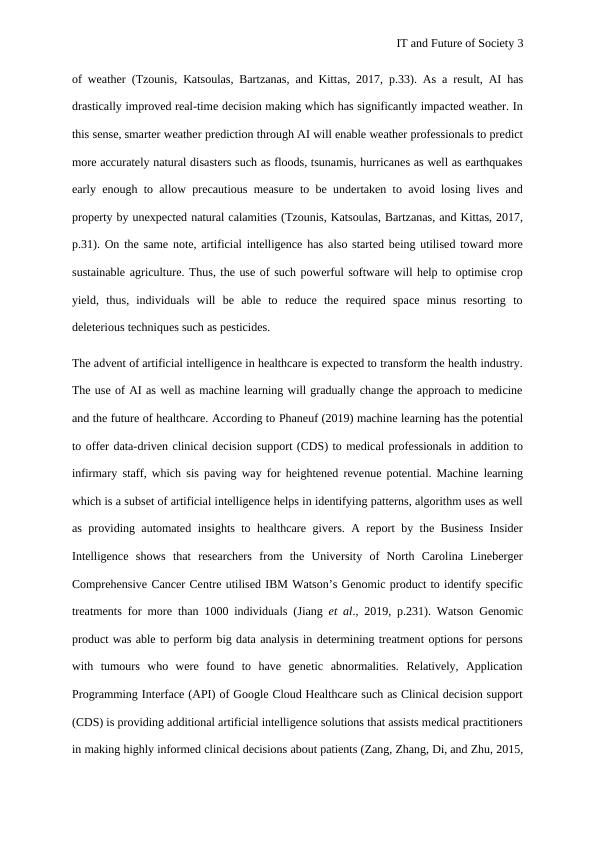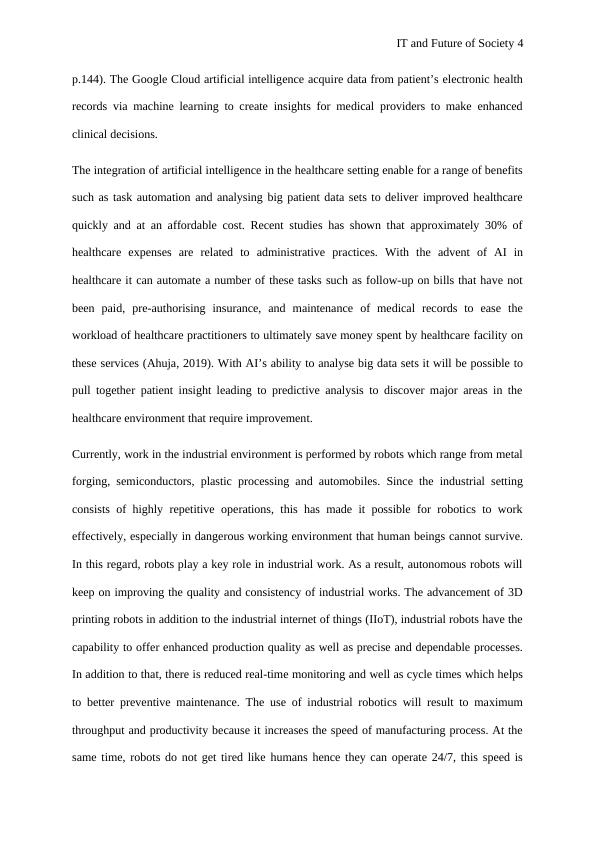IT and Future of Society Research 2022
Discuss the positive and negative impacts of the development of autonomous robots on our lives.
12 Pages3191 Words30 Views
Added on 2022-09-29
IT and Future of Society Research 2022
Discuss the positive and negative impacts of the development of autonomous robots on our lives.
Added on 2022-09-29
ShareRelated Documents
IT and Future of Society 1
IT AND FUTURE OF SOCIETY
by [Name]
Professor’s Name
Course Title
Course Code
State/City
Date
IT AND FUTURE OF SOCIETY
by [Name]
Professor’s Name
Course Title
Course Code
State/City
Date

IT and Future of Society 2
Introduction
In the present world, it has become almost next to impossible for an average human to
accomplish their day-to-day operations minus the use of technology at some point. Indeed,
the rapid progress of information technology over the years has been inclined towards getting
solutions and convenience. In this regard, technology is being used to make work easier as
well as help humanity with innovation offering solutions that could not have been possible
without this option. Nevertheless, there is a growing notion that the society is transitioning
into a “robot society” (Makridakis, 2017, p.51). Recent studies by Casares (2018, p.7) shows
that the inexorable increase in robot as the fundamental shift in developed economies is likely
to transform the nature of work as well as opportunity within society. Certainly, the robot has
apparently become a spectre threat to the economic security not only to the working poor but
also the middle class across mature societies (Torresen, 2018, p.75). Technology is taking
almost each aspect of life hence this comes with negative impacts. The integration between
technology and human beings create risks such as replacement of jobs done by human by
robots, health related ailments because of addition to computer gaming. This paper
investigate how the development of autonomous robots will transform the future of society
both positively and negative.
Artificial intelligence has brought impressive applications with remarkable benefits for all in
several ways. To begin with the advancements in autonomous robots has led to smarter
weather prediction and agriculture. Research has shown that accurate prediction of weather
can be difficult to challenging and difficult with errors which are likely to hurt businesses,
endanger lives particularly for people who lack the ability to promptly seek shelter and when
need arise and disrupt travel. Nonetheless, the birth of artificial intelligence gives solutions
by analysing data and making future predictions. In accordance to the American
Meteorological Society (AMS), artificial intelligence has been a game changer in prediction
Introduction
In the present world, it has become almost next to impossible for an average human to
accomplish their day-to-day operations minus the use of technology at some point. Indeed,
the rapid progress of information technology over the years has been inclined towards getting
solutions and convenience. In this regard, technology is being used to make work easier as
well as help humanity with innovation offering solutions that could not have been possible
without this option. Nevertheless, there is a growing notion that the society is transitioning
into a “robot society” (Makridakis, 2017, p.51). Recent studies by Casares (2018, p.7) shows
that the inexorable increase in robot as the fundamental shift in developed economies is likely
to transform the nature of work as well as opportunity within society. Certainly, the robot has
apparently become a spectre threat to the economic security not only to the working poor but
also the middle class across mature societies (Torresen, 2018, p.75). Technology is taking
almost each aspect of life hence this comes with negative impacts. The integration between
technology and human beings create risks such as replacement of jobs done by human by
robots, health related ailments because of addition to computer gaming. This paper
investigate how the development of autonomous robots will transform the future of society
both positively and negative.
Artificial intelligence has brought impressive applications with remarkable benefits for all in
several ways. To begin with the advancements in autonomous robots has led to smarter
weather prediction and agriculture. Research has shown that accurate prediction of weather
can be difficult to challenging and difficult with errors which are likely to hurt businesses,
endanger lives particularly for people who lack the ability to promptly seek shelter and when
need arise and disrupt travel. Nonetheless, the birth of artificial intelligence gives solutions
by analysing data and making future predictions. In accordance to the American
Meteorological Society (AMS), artificial intelligence has been a game changer in prediction

IT and Future of Society 3
of weather (Tzounis, Katsoulas, Bartzanas, and Kittas, 2017, p.33). As a result, AI has
drastically improved real-time decision making which has significantly impacted weather. In
this sense, smarter weather prediction through AI will enable weather professionals to predict
more accurately natural disasters such as floods, tsunamis, hurricanes as well as earthquakes
early enough to allow precautious measure to be undertaken to avoid losing lives and
property by unexpected natural calamities (Tzounis, Katsoulas, Bartzanas, and Kittas, 2017,
p.31). On the same note, artificial intelligence has also started being utilised toward more
sustainable agriculture. Thus, the use of such powerful software will help to optimise crop
yield, thus, individuals will be able to reduce the required space minus resorting to
deleterious techniques such as pesticides.
The advent of artificial intelligence in healthcare is expected to transform the health industry.
The use of AI as well as machine learning will gradually change the approach to medicine
and the future of healthcare. According to Phaneuf (2019) machine learning has the potential
to offer data-driven clinical decision support (CDS) to medical professionals in addition to
infirmary staff, which sis paving way for heightened revenue potential. Machine learning
which is a subset of artificial intelligence helps in identifying patterns, algorithm uses as well
as providing automated insights to healthcare givers. A report by the Business Insider
Intelligence shows that researchers from the University of North Carolina Lineberger
Comprehensive Cancer Centre utilised IBM Watson’s Genomic product to identify specific
treatments for more than 1000 individuals (Jiang et al., 2019, p.231). Watson Genomic
product was able to perform big data analysis in determining treatment options for persons
with tumours who were found to have genetic abnormalities. Relatively, Application
Programming Interface (API) of Google Cloud Healthcare such as Clinical decision support
(CDS) is providing additional artificial intelligence solutions that assists medical practitioners
in making highly informed clinical decisions about patients (Zang, Zhang, Di, and Zhu, 2015,
of weather (Tzounis, Katsoulas, Bartzanas, and Kittas, 2017, p.33). As a result, AI has
drastically improved real-time decision making which has significantly impacted weather. In
this sense, smarter weather prediction through AI will enable weather professionals to predict
more accurately natural disasters such as floods, tsunamis, hurricanes as well as earthquakes
early enough to allow precautious measure to be undertaken to avoid losing lives and
property by unexpected natural calamities (Tzounis, Katsoulas, Bartzanas, and Kittas, 2017,
p.31). On the same note, artificial intelligence has also started being utilised toward more
sustainable agriculture. Thus, the use of such powerful software will help to optimise crop
yield, thus, individuals will be able to reduce the required space minus resorting to
deleterious techniques such as pesticides.
The advent of artificial intelligence in healthcare is expected to transform the health industry.
The use of AI as well as machine learning will gradually change the approach to medicine
and the future of healthcare. According to Phaneuf (2019) machine learning has the potential
to offer data-driven clinical decision support (CDS) to medical professionals in addition to
infirmary staff, which sis paving way for heightened revenue potential. Machine learning
which is a subset of artificial intelligence helps in identifying patterns, algorithm uses as well
as providing automated insights to healthcare givers. A report by the Business Insider
Intelligence shows that researchers from the University of North Carolina Lineberger
Comprehensive Cancer Centre utilised IBM Watson’s Genomic product to identify specific
treatments for more than 1000 individuals (Jiang et al., 2019, p.231). Watson Genomic
product was able to perform big data analysis in determining treatment options for persons
with tumours who were found to have genetic abnormalities. Relatively, Application
Programming Interface (API) of Google Cloud Healthcare such as Clinical decision support
(CDS) is providing additional artificial intelligence solutions that assists medical practitioners
in making highly informed clinical decisions about patients (Zang, Zhang, Di, and Zhu, 2015,

IT and Future of Society 4
p.144). The Google Cloud artificial intelligence acquire data from patient’s electronic health
records via machine learning to create insights for medical providers to make enhanced
clinical decisions.
The integration of artificial intelligence in the healthcare setting enable for a range of benefits
such as task automation and analysing big patient data sets to deliver improved healthcare
quickly and at an affordable cost. Recent studies has shown that approximately 30% of
healthcare expenses are related to administrative practices. With the advent of AI in
healthcare it can automate a number of these tasks such as follow-up on bills that have not
been paid, pre-authorising insurance, and maintenance of medical records to ease the
workload of healthcare practitioners to ultimately save money spent by healthcare facility on
these services (Ahuja, 2019). With AI’s ability to analyse big data sets it will be possible to
pull together patient insight leading to predictive analysis to discover major areas in the
healthcare environment that require improvement.
Currently, work in the industrial environment is performed by robots which range from metal
forging, semiconductors, plastic processing and automobiles. Since the industrial setting
consists of highly repetitive operations, this has made it possible for robotics to work
effectively, especially in dangerous working environment that human beings cannot survive.
In this regard, robots play a key role in industrial work. As a result, autonomous robots will
keep on improving the quality and consistency of industrial works. The advancement of 3D
printing robots in addition to the industrial internet of things (IIoT), industrial robots have the
capability to offer enhanced production quality as well as precise and dependable processes.
In addition to that, there is reduced real-time monitoring and well as cycle times which helps
to better preventive maintenance. The use of industrial robotics will result to maximum
throughput and productivity because it increases the speed of manufacturing process. At the
same time, robots do not get tired like humans hence they can operate 24/7, this speed is
p.144). The Google Cloud artificial intelligence acquire data from patient’s electronic health
records via machine learning to create insights for medical providers to make enhanced
clinical decisions.
The integration of artificial intelligence in the healthcare setting enable for a range of benefits
such as task automation and analysing big patient data sets to deliver improved healthcare
quickly and at an affordable cost. Recent studies has shown that approximately 30% of
healthcare expenses are related to administrative practices. With the advent of AI in
healthcare it can automate a number of these tasks such as follow-up on bills that have not
been paid, pre-authorising insurance, and maintenance of medical records to ease the
workload of healthcare practitioners to ultimately save money spent by healthcare facility on
these services (Ahuja, 2019). With AI’s ability to analyse big data sets it will be possible to
pull together patient insight leading to predictive analysis to discover major areas in the
healthcare environment that require improvement.
Currently, work in the industrial environment is performed by robots which range from metal
forging, semiconductors, plastic processing and automobiles. Since the industrial setting
consists of highly repetitive operations, this has made it possible for robotics to work
effectively, especially in dangerous working environment that human beings cannot survive.
In this regard, robots play a key role in industrial work. As a result, autonomous robots will
keep on improving the quality and consistency of industrial works. The advancement of 3D
printing robots in addition to the industrial internet of things (IIoT), industrial robots have the
capability to offer enhanced production quality as well as precise and dependable processes.
In addition to that, there is reduced real-time monitoring and well as cycle times which helps
to better preventive maintenance. The use of industrial robotics will result to maximum
throughput and productivity because it increases the speed of manufacturing process. At the
same time, robots do not get tired like humans hence they can operate 24/7, this speed is

End of preview
Want to access all the pages? Upload your documents or become a member.
Related Documents
Artificial Intelligence and Robotics: Impact on Teaching, Healthcare, and Small Business Owners in Australialg...
|14
|3228
|98
Report on Artificial Intelligencelg...
|8
|2648
|229
The Future of Artificial Intelligencelg...
|8
|1729
|157
Artificial Intelligence Assignment Solution (pdf)lg...
|3
|389
|423
The Offense Defense Balance in Cyberspace Assignmentlg...
|20
|4185
|257
How Could Artificial Intelligence Influence the Future - PDFlg...
|5
|399
|428
